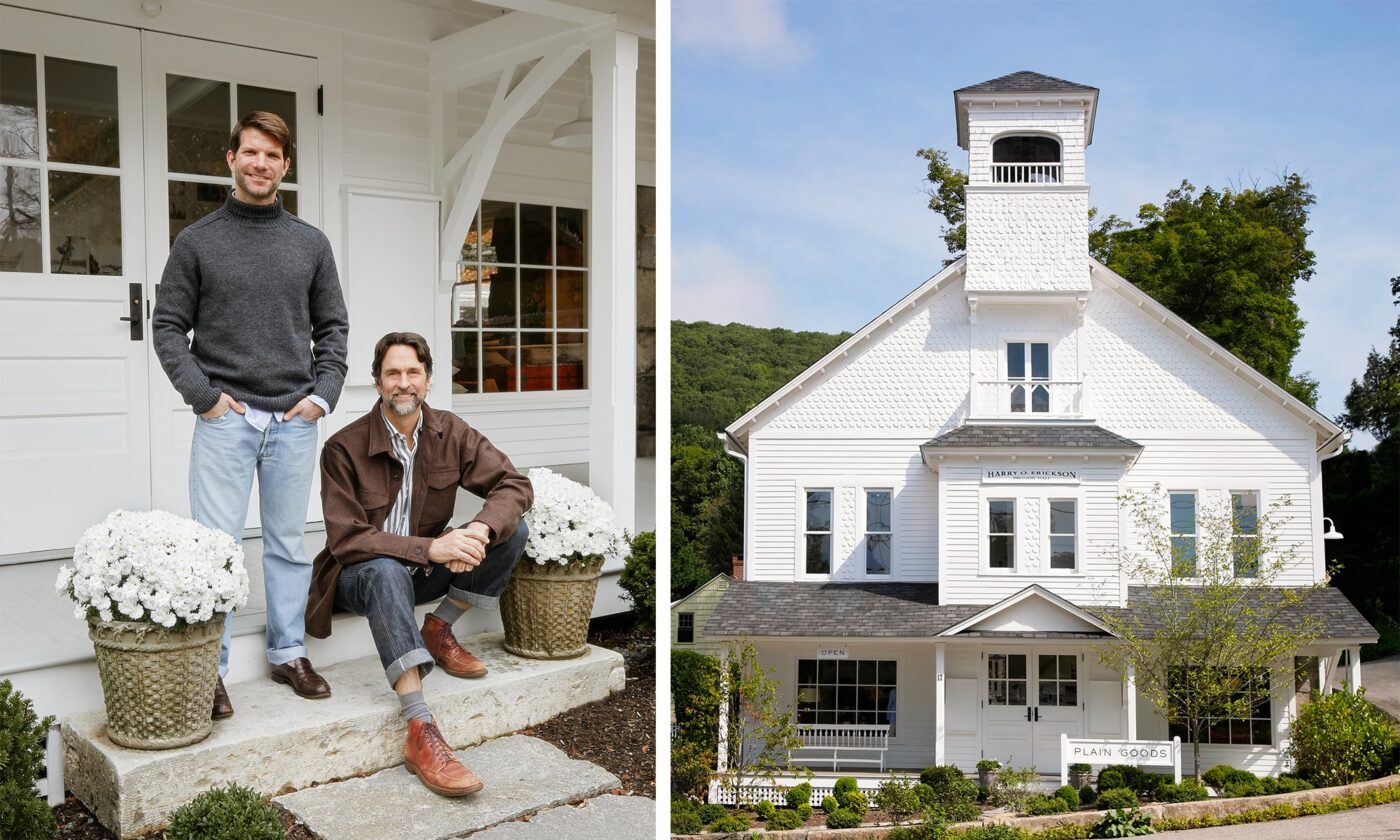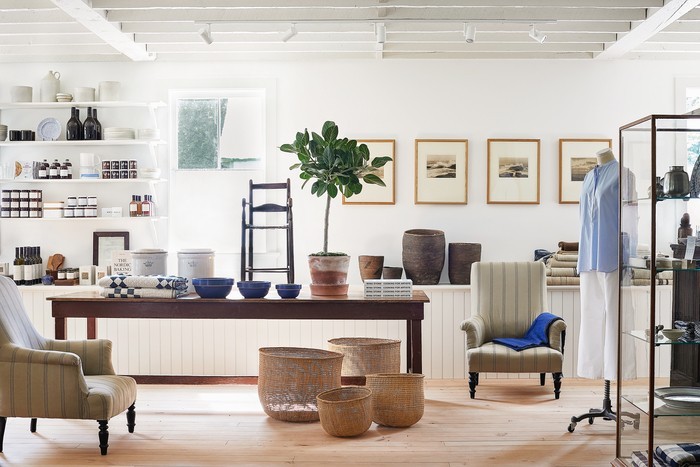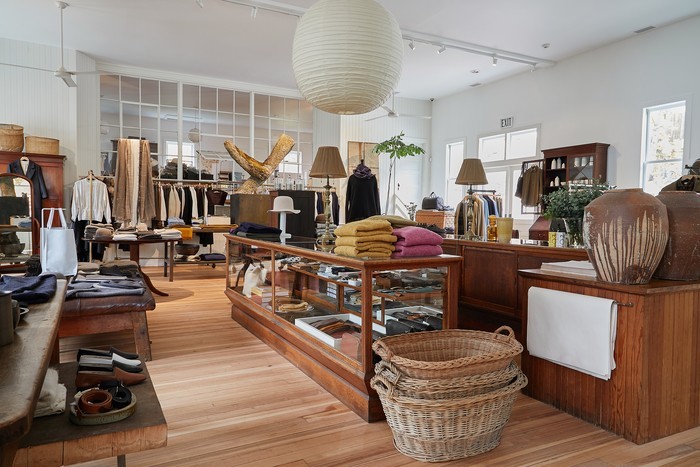A Look Inside Plain Goods: Where Timeless and Modern are Stitched Together Seamlessly

Above: Plain Goods owners Andrew Fry (left) and Michael DePerno (right)
Designer Michael DePerno of Plain Goods in New Preston gives us the detailed scoop on his timeless and thoughtfully curated shop. For the home and wardrobe, Plain Goods maintains a focus on classic design and impeccable craftsmanship; it is a story of history and evolution, with a foundation newly rooted in one of the most iconic buildings in the area. Read on to learn about Michael’s vision and purpose, and the history and incredibly detailed renovation of New Preston’s Pavilion Hall.
Tell us about yourself. You spent years in New York and on the west coast, but discovered the quaint village of New Preston…how did you happen upon it and what ultimately brought you here?
I grew up in Michigan, left at 19 and lived between New York City and Europe for 10 years. While living in the city, I founded my first shop Hope and Wilder located in SoHo, which consisted primarily of antique and vintage items, lines of fabric from England and a namesake line of upholstered furniture. In 1999, I moved to Los Angeles and opened Ren, another home furnishings store with two locations. About six years in I moved to Northern California, where I had shops in Sonoma County.
In 2011, I decided that I wanted to relocate to the east coast. I had been living in an architect-designed mid-century modern house I restored in the hills of Sonoma County. I longed for an antique house, something much older than what I could find in California. While working on several design projects back east, I had the opportunity to explore various regions. I spent time in upstate New York, Pennsylvania, Massachusetts and Connecticut, and it was on one of those visits that I rediscovered Litchfield County.
I decided that this was the place I wanted to be, but wasn’t certain which town I wanted to settle in, so I had to dig a little deeper. In 2012, I met a woman who was selling her family’s 1760s home in Woodbury. A friendship ensued, and as I considered purchasing her home, she suggested I come for an extended visit to get a true sense of the area. What was supposed to be a month or two ended up being a year, and we became dear friends. I soon realized that this house, which I adored, would be too much of a commitment for me. I ended up purchasing a charming old house in Washington, in need of some serious TLC, that I began to restore. It was during this process that I met Andrew.
So then how did Plain Goods come to be?
I’ve always been a collector; sourcing, acquiring, and sharing. Andrew, on the other hand, is more of a minimalist. We made a good team, balancing each other quite nicely. During some of our early visits together, we realized that our shared affinity for beautiful things along with our individual experiences was a solid foundation, and a plan was hatched to open a shop. Andrew’s background is in fashion communications having worked with brands such as Ralph Lauren, Tom Ford, and Burberry. We share a similar aesthetic for clothing and accessories. The home and decorating aspect of it is derived from my past: the shops, design projects, and my personal collections.
We were initially focused on Washington Depot as a location for the shop but eventually, we set our sights on a small cottage in New Preston. We put our personal touches on the interior and exterior of the building thus creating the first home for Plain Goods. We ran the shop out of this location for 3 1/2 years.
We originally thought the focus would be antique and vintage furnishings but it became abundantly clear that because of the size of the space, we couldn’t showcase large scale furniture how we envisioned. We soon realized that our love of quality clothing was a welcome addition, all of which fit ideally in the small space. This was the perfect marriage between my appreciation of textiles and Andrew’s of quality clothing – it suited the shop perfectly. It’s about how a piece of fabric feels against the skin, and how that piece of fabric is cut and sewn. How does it make you feel when you wear it? How can we offer things that are thoughtfully produced, that are unique and aren’t readily available to our customer? Those were important aspects of what we wanted to offer. That’s what we did, and that was what formed Plain Goods.

How do you select pieces to bring into the shop? What strikes you about a piece that inspires you to choose to share it at Plain Goods?
It is the moment you set your eyes on something and it immediately resonates with you. You are somehow in touch with the harmony of many disparate categories that share a common thread. Our shop offers a very tactile experience… it encourages visitors to explore. When you purchase our clothing it is meant to be loved, lasting, and worn.
We want it to become your favorite sweater, your perfect coat, your favorite shoe. Andrew and I tend to agree upon and appreciate many of the items we bring in, which is rare. We are able to move through the fashion shows, antique fairs in Europe, and the home shows swiftly and with a keen eye. We share a singular vision and understanding of what our brand is, what our point of view is, how all of these options fall into that point of view, and then how we selectively edit from hundreds of thousands of products every year.
New Preston draws many savvy shoppers; we have clients from all over the world. We offer something for everyone. The shop has become a destination because of what we select, how we merchandise, and the overall feel of the shop. This combined with nearly 30 years of being a retailer.
This past April, you earned the Connecticut Trust for Historic Preservation Award for your restoration of Pavilion Hall. What does it mean to you and Andrew to have received such a prestigious award? What was the process of restoration and design of an antique building like?
We were deeply honored by the award. It’s always humbling to be recognized for the fruits of one’s labor. This was a straight-from-the-heart restoration. We saved as much of the original fabric as possible and were thoughtful with anything new that was added.
We have furthered the protection of this building with a designation on the State Historic Register, and it will soon be on the National Register of Historic Places. So, for all of the devotion we poured into this project and the hurdles that we overcame, it feels really good that we did something meaningful not only for this building, but also for Washington and our community.
The building is once again an important anchor to the village of New Preston, full of life and lit from within… the work of many skilled craftspeople went into the preservation and restoration of it which is gratifying to experience.
The lower level was redone and stripped bare in the 80s as part of the Boys Club; the work was basic and utilitarian, not a restoration. Upstairs had more of the original details intact in addition to a basketball hoop and court. The original floorboards are Douglas Fir where dances were held. A stage at the far end of the room, was for theater performances. We kept the proscenium and the stage, but we encased it with antique glass casement windows to create our office and photo studio.

The beadboard paneling was milled in Massachusetts by Ponders Hollow; they were able to replicate an existing piece of beadboard and mill exactly what we needed for the lower level. When we exposed the original wall along East Shore Road, we discovered the original granite foundation and two original windows, both of which were restored. To keep things consistent, granite sills were added by Stone Walls by George, for which antique pieces of granite were brought in. Our lead carpenter was able to take cues from existing cabinetry when we created the built-ins and shelving. The concrete slab floor was here under layers of carpet, padding, adhesive, and paint, so for two weeks, the floors were polished with diamond polishing machines from Sweden.
On the west-facing side of the building, all of the windows were restored with antique glass. The shopfront windows on the facade have handblown glass from Germany and the frames were made locally. We sourced all of the interior doors with original hardware intact from the c.1900 McPhillips hotel in the Adirondacks.
It was said by the Trust that, “The most visible building in the village of New Preston, Pavilion Hall, was built in 1897 to provide entertainment for townspeople and vacationers. The restored building anchors the historic village and serves as a model for sensitive adaptive use.” You and Andrew are responsible for the preservation of a building with historical significance, both as an architectural icon in the village and with a storied original purpose. How do you think the building’s current purpose and contents reflect its lively history?
I think in the most obvious sense, it marries the history of the building with a company who is passionate about preservation. A perfect example of adaptive reuse. The building was forlorn and somewhat neglected and sat shuttered for a long time, now it’s open, it’s alive, it belongs here. This village is a retail destination and offers visitors a unique shopping experience. It couldn’t be more fitting that a retailer with our experience, passion, and care is the steward of it.
What do you most enjoy about living and working in town?
I have lived in and visited many places around the country and we’ve traveled extensively, but I must say that Washington is on the top of my list, I’m always happy to return home. Litchfield County is a rare bird in that it offers so much and the quality of life is outstanding. It’s physically and visually beautiful and our lifestyle is relaxed and comfortable.
We have a great community here, which helps make this place feel like home. There’s always something to do and a formidable social component or it’s just as easy to be puttering in the garden, being quiet with the dogs. Nature abounds, which nourishes the soul. It’s a very special place.
We love hearing about local favorites from locals themselves. Can you share some of your favorite restaurants, shops (besides Plain Goods, of course!), and things to do?
I have many favorites. The Pantry is wonderful, it reminds me of the places that I grew up going to in Michigan. The GW Tavern is cozy, the staff is friendly, and we love the filet. Community Table does an exquisite job, top to bottom, and it’s consistently good. The Hopkins Inn is another favorite for comfort food, the meringue glacee is sinfully good.
A real favorite is Hickory Stick Bookshop—it is one of the best places to unwind. They carry a wonderful range of books and will order anything you want. I’m not an online buyer. I like the experience as well as being able to support local businesses.
I adore the Gunn Memorial Library in Washington; I have about 10 books out right now—it’s an incredible resource. I relish the quiet and peacefulness. The views of nature are equally pleasing.
The property and gardens at Hollister House Garden always inspire and the yearly rare plant sale is great for finding something new and unusual.
The current exhibit at the Gunn Museum is fantastic. I appreciate the amount of effort that was put into it. I enjoy Steep Rock for quiet walks along the river, the Pinnacle for hiking, and we try to go swimming as much as possible in Lake Waramaug.
Learn More about Plain Goods
17 E Shore Road
New Preston, CT 06777
www.plain-goods.com
Photo credits: Plain Goods